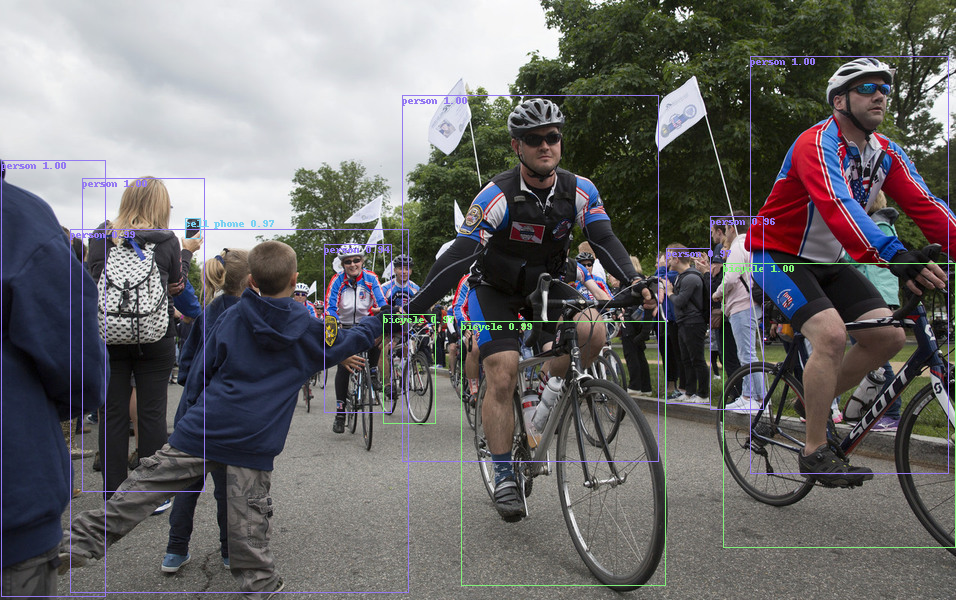torchvision.models 里包含了许多模型,用于解决不同的视觉任务:图像分类、语义分割、物体检测、实例分割、人体关键点检测和视频分类。
本文将介绍 torchvision 中模型的入门使用,一起来创建 Faster R-CNN 预训练模型,预测图像中有什么物体吧。
import torch
import torchvision
from PIL import Image
创建预训练模型
model = torchvision.models.detection.fasterrcnn_resnet50_fpn(pretrained=True)
print(model) 可查看其结构:
FasterRCNN(
(transform): GeneralizedRCNNTransform(
Normalize(mean=[0.485, 0.456, 0.406], std=[0.229, 0.224, 0.225])
Resize(min_size=(800,), max_size=1333, mode='bilinear')
)
(backbone): BackboneWithFPN(
...
)
(rpn): RegionProposalNetwork(
(anchor_generator): AnchorGenerator()
(head): RPNHead(
(conv): Conv2d(256, 256, kernel_size=(3, 3), stride=(1, 1), padding=(1, 1))
(cls_logits): Conv2d(256, 3, kernel_size=(1, 1), stride=(1, 1))
(bbox_pred): Conv2d(256, 12, kernel_size=(1, 1), stride=(1, 1))
)
)
(roi_heads): RoIHeads(
(box_roi_pool): MultiScaleRoIAlign(featmap_names=['0', '1', '2', '3'], output_size=(7, 7), sampling_ratio=2)
(box_head): TwoMLPHead(
(fc6): Linear(in_features=12544, out_features=1024, bias=True)
(fc7): Linear(in_features=1024, out_features=1024, bias=True)
)
(box_predictor): FastRCNNPredictor(
(cls_score): Linear(in_features=1024, out_features=91, bias=True)
(bbox_pred): Linear(in_features=1024, out_features=364, bias=True)
)
)
)
此预训练模型是于 COCO train2017 上训练的,可预测的分类有:
COCO_INSTANCE_CATEGORY_NAMES = [
'__background__', 'person', 'bicycle', 'car', 'motorcycle', 'airplane', 'bus',
'train', 'truck', 'boat', 'traffic light', 'fire hydrant', 'N/A', 'stop sign',
'parking meter', 'bench', 'bird', 'cat', 'dog', 'horse', 'sheep', 'cow',
'elephant', 'bear', 'zebra', 'giraffe', 'N/A', 'backpack', 'umbrella', 'N/A', 'N/A',
'handbag', 'tie', 'suitcase', 'frisbee', 'skis', 'snowboard', 'sports ball',
'kite', 'baseball bat', 'baseball glove', 'skateboard', 'surfboard', 'tennis racket',
'bottle', 'N/A', 'wine glass', 'cup', 'fork', 'knife', 'spoon', 'bowl',
'banana', 'apple', 'sandwich', 'orange', 'broccoli', 'carrot', 'hot dog', 'pizza',
'donut', 'cake', 'chair', 'couch', 'potted plant', 'bed', 'N/A', 'dining table',
'N/A', 'N/A', 'toilet', 'N/A', 'tv', 'laptop', 'mouse', 'remote', 'keyboard', 'cell phone',
'microwave', 'oven', 'toaster', 'sink', 'refrigerator', 'N/A', 'book',
'clock', 'vase', 'scissors', 'teddy bear', 'hair drier', 'toothbrush'
]
指定 CPU or GPU
获取支持的 device:
device = torch.device('cuda') if torch.cuda.is_available() else torch.device('cpu')
模型移到 device:
model.to(device)
读取输入图像
img = Image.open('data/bicycle.jpg').convert("RGB")
img = torchvision.transforms.ToTensor()(img)
准备模型入参 images:
images = [img.to(device)]
例图 data/bicycle.jpg:

进行模型推断
模型切为 eval 模式:
# For inference
model.eval()
模型在推断时,只需要给到图像数据,不用标注数据。推断后,会返回每个图像的预测结果 List[Dict[Tensor]]。Dict 包含字段有:
- boxes (
FloatTensor[N, 4]): 预测框[x1, y1, x2, y2],x范围[0,W],y范围[0,H] - labels (
Int64Tensor[N]): 预测类别 - scores (
Tensor[N]): 预测评分
predictions = model(images)
pred = predictions[0]
print(pred)
预测结果如下:
{'boxes': tensor([[750.7896, 56.2632, 948.7942, 473.7791],
[ 82.7364, 178.6174, 204.1523, 491.9059],
...
[174.9881, 235.7873, 351.1031, 417.4089],
[631.6036, 278.6971, 664.1542, 353.2548]], device='cuda:0',
grad_fn=<StackBackward>), 'labels': tensor([ 1, 1, 2, 1, 1, 1, 2, 2, 1, 77, 1, 1, 1, 2, 1, 1, 1, 1,
1, 1, 27, 1, 1, 44, 1, 1, 1, 1, 27, 1, 1, 32, 1, 44, 1, 1,
31, 2, 38, 2, 2, 1, 1, 31, 1, 1, 1, 1, 2, 1, 1, 1, 1, 1,
1, 1, 1, 1, 1, 2, 2, 1, 1, 1, 2, 1, 1, 1, 1, 2, 1, 2,
1, 1, 1, 1, 1, 1, 31, 2, 27, 1, 2, 1, 1, 31, 2, 77, 2, 1,
2, 2, 2, 44, 2, 31, 1, 1, 1, 1], device='cuda:0'), 'scores': tensor([0.9990, 0.9976, 0.9962, 0.9958, 0.9952, 0.9936, 0.9865, 0.9746, 0.9694,
0.9679, 0.9620, 0.9395, 0.8984, 0.8979, 0.8847, 0.8537, 0.8475, 0.7865,
0.7822, 0.6896, 0.6633, 0.6629, 0.6222, 0.6132, 0.6073, 0.5383, 0.5248,
0.4891, 0.4881, 0.4595, 0.4335, 0.4273, 0.4089, 0.4074, 0.3679, 0.3357,
0.3192, 0.3102, 0.2797, 0.2655, 0.2640, 0.2626, 0.2615, 0.2375, 0.2306,
0.2174, 0.2129, 0.1967, 0.1912, 0.1907, 0.1739, 0.1722, 0.1669, 0.1666,
0.1596, 0.1586, 0.1473, 0.1456, 0.1408, 0.1374, 0.1373, 0.1329, 0.1291,
0.1290, 0.1289, 0.1278, 0.1205, 0.1182, 0.1182, 0.1103, 0.1060, 0.1025,
0.1010, 0.0985, 0.0959, 0.0919, 0.0887, 0.0886, 0.0873, 0.0832, 0.0792,
0.0778, 0.0764, 0.0693, 0.0686, 0.0679, 0.0671, 0.0668, 0.0636, 0.0635,
0.0607, 0.0605, 0.0581, 0.0578, 0.0572, 0.0568, 0.0557, 0.0556, 0.0555,
0.0533], device='cuda:0', grad_fn=<IndexBackward>)}
绘制预测结果
获取 score >= 0.9 的预测结果:
scores = pred['scores']
mask = scores >= 0.9
boxes = pred['boxes'][mask]
labels = pred['labels'][mask]
scores = scores[mask]
引入 utils.plots.plot_image 绘制结果:
from utils.colors import golden
from utils.plots import plot_image
lb_names = COCO_INSTANCE_CATEGORY_NAMES
lb_colors = golden(len(lb_names), fn=int, scale=0xff, shuffle=True)
lb_infos = [f'{s:.2f}' for s in scores]
plot_image(img, boxes, labels, lb_names, lb_colors, lb_infos,
save_name='result.png')
utils.plots.plot_image函数实现可见后文源码,注意其要求torchvision >= 0.9.0/nightly。

源码
utils.colors.golden:
import colorsys
import random
def golden(n, h=random.random(), s=0.5, v=0.95,
fn=None, scale=None, shuffle=False):
if n <= 0:
return []
coef = (1 + 5**0.5) / 2
colors = []
for _ in range(n):
h += coef
h = h - int(h)
color = colorsys.hsv_to_rgb(h, s, v)
if scale is not None:
color = tuple(scale*v for v in color)
if fn is not None:
color = tuple(fn(v) for v in color)
colors.append(color)
if shuffle:
random.shuffle(colors)
return colors
utils.plots.plot_image:
from typing import Union, Optional, List, Tuple
import matplotlib.pyplot as plt
import numpy as np
import torch
import torchvision
from PIL import Image
def plot_image(
image: Union[torch.Tensor, Image.Image, np.ndarray],
boxes: Optional[torch.Tensor] = None,
labels: Optional[torch.Tensor] = None,
lb_names: Optional[List[str]] = None,
lb_colors: Optional[List[Union[str, Tuple[int, int, int]]]] = None,
lb_infos: Optional[List[str]] = None,
save_name: Optional[str] = None,
show_name: Optional[str] = 'result',
) -> torch.Tensor:
"""
Draws bounding boxes on given image.
Args:
image (Image): `Tensor`, `PIL Image` or `numpy.ndarray`.
boxes (Optional[Tensor]): `FloatTensor[N, 4]`, the boxes in `[x1, y1, x2, y2]` format.
labels (Optional[Tensor]): `Int64Tensor[N]`, the class label index for each box.
lb_names (Optional[List[str]]): All class label names.
lb_colors (List[Union[str, Tuple[int, int, int]]]): List containing the colors of all class label names.
lb_infos (Optional[List[str]]): Infos for given labels.
save_name (Optional[str]): Save image name.
show_name (Optional[str]): Show window name.
"""
if not isinstance(image, torch.Tensor):
image = torchvision.transforms.ToTensor()(image)
if boxes is not None:
if image.dtype != torch.uint8:
image = torchvision.transforms.ConvertImageDtype(torch.uint8)(image)
draw_labels = None
draw_colors = None
if labels is not None:
draw_labels = [lb_names[i] for i in labels] if lb_names is not None else None
draw_colors = [lb_colors[i] for i in labels] if lb_colors is not None else None
if draw_labels and lb_infos:
draw_labels = [f'{l} {i}' for l, i in zip(draw_labels, lb_infos)]
# torchvision >= 0.9.0/nightly
# https://github.com/pytorch/vision/blob/master/torchvision/utils.py
res = torchvision.utils.draw_bounding_boxes(image, boxes,
labels=draw_labels, colors=draw_colors)
else:
res = image
if save_name or show_name:
res = res.permute(1, 2, 0).contiguous().numpy()
if save_name:
Image.fromarray(res).save(save_name)
if show_name:
plt.gcf().canvas.set_window_title(show_name)
plt.imshow(res)
plt.show()
return res
参考
GoCoding 个人实践的经验分享,可关注公众号!